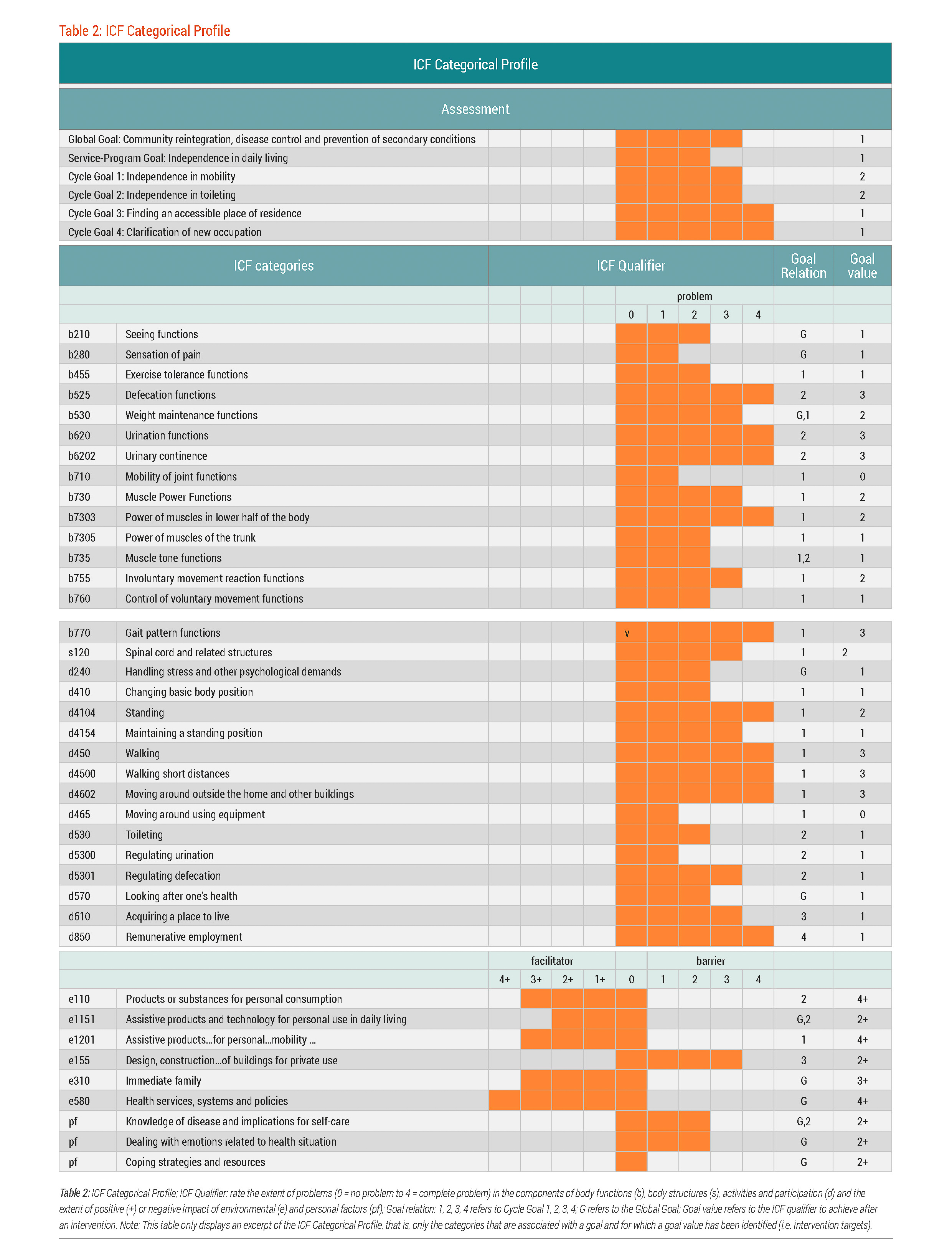Goal-setting/Determination of Intervention Targets
The comprehensive overview of Marco's functioning, as documented on the ICF Assessment Sheet, facilitated goal-setting and in determining the intervention targets.
What To Strive For
In Marco's case, he and his rehabilitation team defined ‘community reintegration, disease control and prevention of secondary conditions’ as the multi-prong long-term global goal. In addition, they defined ‘independence in daily living’ as a service-program goal i.e. the more specific goal that they would like to strive for during this Rehab-Cycle®. As smaller, more concrete goals that serve as the "stepping stones" toward reaching the service program goal, Marco and his rehabilitation team defined four cycle goals:
- Cycle Goal 1: Independence in mobility
- Cycle Goal 2: Independence in toileting
- Cycle Goal 3: Finding an accessible place of residence
- Cycle Goal 4: Clarification of new occupation
These goals were documented on the ICF Categorical Profile, a visual depiction (bar chart) of Marco's functioning status at the time of assessment. The ICF Categorical Profile depicts the extent of the problem Marco was having in various aspects of functioning as represented by relevant categories of the International Classification of Functioning, Disability and Health (ICF)14. The extent of the problem was rated using ICF qualifiers. See table 2.

Table 2: ICF Categorical Profile; ICF Qualifier: rate the extent of problems (0 = no problem to 4 = complete problem) in the components of body functions (b), body structures (s), activities and participation (d) and the extent of positive (+) or negative impact of environmental (e) and personal factors (pf); Goal relation: 1, 2, 3, 4 refer to Cycle Goal 1, 2, 3, 4; G refers to the Global Goal; Goal value refers to the ICF qualifier to achieve after an intervention. Note: This table only displays an excerpt of the ICF Categorical Profile, that is, only the categories that are associated with a goal and for which a goal value has been identified (i.e. intervention targets).
What To Target
For the goals set, Marco and his rehabilitation team defined one or more intervention targets. Intervention targets were the ICF categories (and personal factors) that corresponded to any of the cycle goals, the service-program goal and/or the global goal Marco and his rehabilitation team set, and that they intended to addressed with specific interventions during the intervention phase of the Rehab-Cycle®. The ICF Categorical Profile also showed the ICF qualifier rating (goal value) that Marco and his team planned to reach in the respective ICF category after intervention.
""To facilitate improvements in Marco's ability to manage his bowel and bladder, they also defined environmental factors...""
For example for Marco's cycle goal 4 ‘independence in toileting’, the intervention targets included the body functions b620 Urination functions, b6202 Urinary continence, and b735 Muscle tone functions. Muscle tone functions was related to reducing the bowel spasticity Marco had been experiencing. Logically, they also defined d540 Toileting, d5300 Regulating urination, d5301 Regulating defecation as intervention targets. To facilitate improvements in Marco's ability to manage his bowel and bladder, they also defined environmental factors – e110 Products or substances for personal consumption and e1151 Assistive products and technology for personal use in daily living. These represented medication/suppositories as well as catheters and an abdominal belt. Last but not least, Marco and his rehabilitation decide to also target the personal factor of Marco's knowledge about his disease and its implications for his self-care. The hope was that the more Marco understood about his disease, the easier it would be for him to manage his bowel and bladder.
Marco's intervention targets were documented on the ICF Intervention Table, a documentation tool that was employed during the intervention phase of the Rehab-Cycle®.